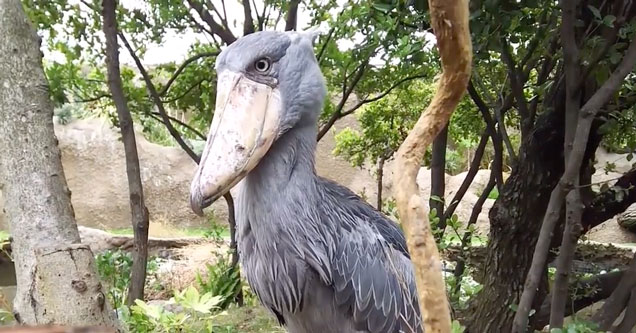

Though otherwise silent, they will also make a whining or mewing sound to communicate.ĭespite its enormous size, the shoebill stork has the ability to soar high above the wetlands on gusts of thermal wind. The shoebill will actually employ a technique called bill clattering to greet each other by pressing their bills together.

That does not mean it is bereft of all social niceties, however. Even its mating partner will usually forage on opposite sides of the territory. Any encounters with other shoebills during its daytime foraging excursions are generally unwanted and undesirable. The shoebill stork can perhaps be described as an anti-social bird. The Shoebill stork, Balaeniceps rex, also known as Whalehead or Shoe-billed Stork, is a very large Stork-like bird. Males are slightly larger in terms of body and bill size. Standing between 4.5 and 5.5 feet in height (and with a weight of 12 pounds), the shoebill stork is among the largest birds in the world. As you can probably imagine, this large bill also needs a strong head, neck, and body to support it. Much of the bill is composed of hard keratin, the same substance as nails and horns. As one of the largest bills among all living birds, it’s used to catch and swallow large prey whole. By far the most prominent characteristic, though, is the massive shoe-like bill that ends in a curved hook, rightly earning this bird the nickname of whale headed. It’s characterized by long, spindly legs, blue to grey plumage, a powdered down on the breast and stomach, and a small tuft of feathers at the back of the head that forms a crest. The appearance of the shoebill stork has sometimes been likened to a dinosaur. The genus name Balaeniceps is actually the combination of two Latin words that roughly translate into English as “whale headed.” Rex, meanwhile, means king or ruler in Latin, which refers to the bird’s exceptionally large size. The scientific name of the shoebill storks is Balaeniceps rex. It is made from a collection of reeds, papyrus, and grasses. The stork’s nest is usually located on an island or a mass of floating vegetation in the middle of the swamp. The shoebill stork is commonly found in the dense marshlands and freshwater swamps of East Africa, including the countries of Uganda, Tanzania, South Sudan, and Zambia.Ĭan You Ace This Quiz? Will you be the 9th? Take Our Brand New A-Z-Animals Birds Quiz Shoebill Stork Nests


The shoebill is the only living member of its family. Standing tall on its long, stilt-like legs, the shoebill stork cuts an imposing figure as it stalks slowly through the dense wetlands for its prey without making a sound.Īlthough it was once classified as a stork, it’s actually more closely related to the herons, hamerkop, and pelicans within the completely separate order of Pelecaniformes.


 0 kommentar(er)
0 kommentar(er)
